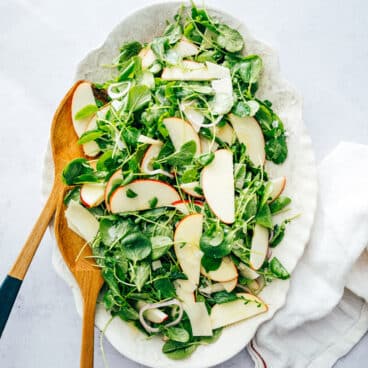It’s feathery, it’s peppery, and it’s the world’s most nutrient dense food. That’s right: it’s watercress! This underappreciated leafy green is also one of the oldest documented greens on the planet, and it’s been fueling humans for millennia. Its peppery flavor is fantastic in salads, as a green in sandwiches, and even in soups and on pizza. Here’s more about this superfood and some of our favorite watercress recipes.
What is watercress?
Watercress is a peppery, leafy green that’s used for salads, sandwiches and soups. It’s one of the oldest documented greens, dating back to ancient Greece and Rome. The world’s first doctor, Hippocrates, established a hospital in 400 BC alongside a river so his patients had a constant supply of watercress. Watercress has a bold, peppery flavor with a bitter finish. In 2014, watercress was named the world’s most nutrient dense food, in a CDC study on powerhouse fruits and vegetables. Gram for gram is contains more Vitamin C than oranges, more vitamin E than broccoli, more calcium than milk and more folate than bananas (source). Watercress a cruciferous vegetable that’s in the same plant family as broccoli, cauliflower, Brussels sprouts and kale. It’s an aquatic plant, so in the wild it tends to grow partially submerged in running water or in flooded areas. Most watercress today is grown hydroponically. What’s a watercress substitute? Try baby arugula, which has a similar peppery flavor.
Buying and storing watercress
What to look for when you’re buying watercress at the store? Here’s what to know:
Choose bags of leaves with crisp, sturdy leaves and perky stems. We prefer baby watercress that comes in bags, instead of mature watercress that comes in a bunch (which can taste very bitter and spicy). Avoid wilted or slimy watercress. Store in an airtight container, plastic bag or in plastic wrap in the crisper drawer of the refrigerator. It should stay good for up to 3 days (or more, depending on the freshness when you purchase).
Watercress nutrition
According to a CDC study on powerhouse fruits and vegetables, watercress is the most nutrient-dense of all produce. It’s packed with Vitamin A, Vitamin K and Vitamin C. Here’s an outline of watercress nutrition:
It’s very low in calories. One cup has only 4 calories (source).It’s loaded with vitamins. One cup has 22% of your daily Vitamin A, 24% of your daily Vitamin C, and 106% of your daily Vitamin K. It also contains calcium and protein. One cup has 4% of your daily calcium and 1 gram of protein.
Watercress recipes
Watercress is ideal for salads, but it’s also common in sandwiches. For example, a watercress sandwich is a traditional British tea sandwich from the Victorian era. It’s also tasty sauteed or as a soup. Here are a few great ideas for watercress recipes: 5 from 1 review **If all you have is kosher salt or flaky sea salt, you can combine these quantities to taste. The flaky sea salt is a nice finishing salt for a salad.








